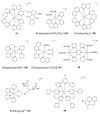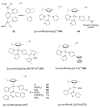The Development of Ru(II)-Based Photoactivated Chemotherapy Agents
- PMID: 34577150
- PMCID: PMC8465985
- DOI: 10.3390/molecules26185679
The Development of Ru(II)-Based Photoactivated Chemotherapy Agents
Abstract
Photoactivated chemotherapy (PACT) is a novel cancer treatment method that has drawn increasing attention due to its high selectivity and low side effects by spatio-temporal control of irradiation. Compared with photodynamic therapy (PDT), oxygen-independent PACT is more suitable for treating hypoxic tumors. By finely tuning ligand structures and coordination configurations, many Ru(II) complexes can undergo photoinduced ligand dissociation, and the resulting Ru(II) aqua species and/or free ligands may have anticancer activity, showing their potential as PACT agents. In this mini-review, we summarized the progress in Ru(II)-based PACT agents, as well as challenges that researchers in this field still face.
Keywords: Ru(II) complexes; photoactivated chemotherapy (PACT); photoinduced ligand dissociation.
Conflict of interest statement
The authors declare no conflict of interest.
Figures










Similar articles
-
Ruthenium-Based Photoactivated Chemotherapy.J Am Chem Soc. 2023 Nov 1;145(43):23397-23415. doi: 10.1021/jacs.3c01135. Epub 2023 Oct 17. J Am Chem Soc. 2023. PMID: 37846939 Free PMC article. Review.
-
Ruthenium Complexes as Anticancer Agents: A Brief History and Perspectives.Drug Des Devel Ther. 2020 Dec 3;14:5375-5392. doi: 10.2147/DDDT.S275007. eCollection 2020. Drug Des Devel Ther. 2020. PMID: 33299303 Free PMC article. Review.
-
Polypyridyl Ruthenium(II) Complexes with Red-Shifted Absorption: New Promises in Photodynamic Therapy.Chembiochem. 2021 Jul 15;22(14):2407-2409. doi: 10.1002/cbic.202100102. Epub 2021 Apr 14. Chembiochem. 2021. PMID: 33710756 Review.
-
Fusion of photodynamic therapy and photoactivated chemotherapy: a novel Ru(II) arene complex with dual activities of photobinding and photocleavage toward DNA.Dalton Trans. 2014 Nov 7;43(41):15375-84. doi: 10.1039/c4dt01755b. Dalton Trans. 2014. PMID: 25188424
-
A mitochondria-targeting dinuclear Ir-Ru complex as a synergistic photoactivated chemotherapy and photodynamic therapy agent against cisplatin-resistant tumour cells.Chem Commun (Camb). 2019 Oct 25;55(83):12547-12550. doi: 10.1039/c9cc05998a. Epub 2019 Oct 2. Chem Commun (Camb). 2019. PMID: 31576841
Cited by
-
Two in one: merging photoactivated chemotherapy and photodynamic therapy to fight cancer.Chem Sci. 2024 Oct 15;15(43):17760-80. doi: 10.1039/d4sc04608k. Online ahead of print. Chem Sci. 2024. PMID: 39464604 Free PMC article. Review.
-
Toward the Treatment of Glioblastoma Tumors Using Photoactivated Chemotherapy: In Vitro Evaluation of Efficacy and Safety.ACS Pharmacol Transl Sci. 2025 Jan 30;8(2):484-498. doi: 10.1021/acsptsci.4c00600. eCollection 2025 Feb 14. ACS Pharmacol Transl Sci. 2025. PMID: 39974641
-
Cyclic Ruthenium-Peptide Conjugates as Integrin-Targeting Phototherapeutic Prodrugs for the Treatment of Brain Tumors.J Am Chem Soc. 2023 Jul 12;145(27):14963-14980. doi: 10.1021/jacs.3c04855. Epub 2023 Jun 28. J Am Chem Soc. 2023. PMID: 37379365 Free PMC article.
-
Light Activated Release of Nitrile Ligands from trans-Ru(L)(PPh3)2(nitrile) Complexes.ACS Omega. 2024 Jul 25;9(31):34098-34105. doi: 10.1021/acsomega.4c04917. eCollection 2024 Aug 6. ACS Omega. 2024. PMID: 39130607 Free PMC article.
-
The Combination of Active-Targeted Photodynamic Therapy and Photoactivated Chemotherapy for Enhanced Cancer Treatment.J Biophotonics. 2025 Jun;18(6):e70005. doi: 10.1002/jbio.70005. Epub 2025 Mar 14. J Biophotonics. 2025. PMID: 40083278 Free PMC article. Review.
References
Publication types
MeSH terms
Substances
Grants and funding
- 21701018/National Natural Science Foundation of China
- 21571181/National Natural Science Foundation of China
- 21773277/National Natural Science Foundation of China
- 20200125/Science and Technology Planning Project of Yuzhong District of Chongqing City
- YXY2020SDTR01/Discipline talent training program of College of pharmacy
LinkOut - more resources
Full Text Sources
Miscellaneous

